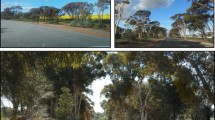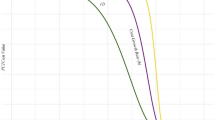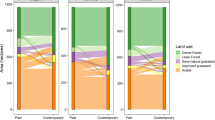Abstract
Context
Restoring or establishing corridors between residual forest patches is one of the most adopted strategies for the conservation of animal populations and ecosystem processes in fragmented landscapes.
Objectives
This study aimed to assess whether it is more effective to focus restoration actions on existing corridors or to establish habitats in other strategic areas that can create new dispersal pathways to enhance connectivity.
Methods
We considered a real agroecosystem in northern Italy, based our analyses on graph-theory and habitat availability metrics, and focused on the Hazel Dormouse as the target species. We compared the connectivity increase resulting from (i) the simulated restoration of existing priority corridors, i.e., those with significant presence of forest but in which restoration actions would still result in considerable connectivity gains, or (ii) the simulated plantation of 30 hedgerows along new priority pathways, i.e., those areas with no current forest cover in which habitat creation would be more beneficial for connectivity.
Results
Implementing new priority pathways resulted in substantially larger connectivity gains (+ 38%) than when restoration efforts were concentrated in improving already existing corridors (+ 11%).
Conclusions
Establishing hedgerows along new pathways allowed enhancing the complementary and functionality of the full set of landscape corridors and proved more efficient than just strengthening the areas where dispersal flows were already concentrated. We demonstrated the importance of analytical procedures able to compare the effectiveness of different management strategies for enhancing connectivity. Our approach may be applied to multiple species sensitive to fragmentation in other heterogeneous landscapes and geographical contexts.



Similar content being viewed by others
References
Adriaensen F, Chardon JP, De Blust G, Swinnen E, Villalba S, Gulinck H, Matthysen E (2003) The application of ‘least-cost’ modelling as a functional landscape model. Landsc Urban Plan 64:233–247
Bani L, Orioli V, Pisa G, Dondina O, Fagiani S, Fabbri E, Randi E, Mortelliti A, Sozio G (2018) Landscape determinants of genetic differentiation, inbreeding and genetic drift in the Hazel Dormouse (Muscardinus avellanarius). Conserv Genet 19:283–296
Bani L, Orioli V, Pisa G, Fagiani S, Dondina O, Fabbri E, Randi E, Sozio G, Mortelliti A (2017) Population genetic structure and sex-biased dispersal of the Hazel Dormouse (Muscardinus avellanarius) in a continuous and in a fragmented landscape in central Italy. Conserv Genet 18:261–274
Bani L, Pisa G, Luppi M, Spilotros G, Fabbri E, Randi E, Orioli V (2015) Ecological connectivity assessment in a strongly structured fire salamander (Salamandra salamandra) population. Ecol Evol 5:3472–3485
Beier P, Majka DR, Newell SL (2009) Uncertainty analysis of least-cost modeling for designing wildlife linkages. Ecol Appl 19:2067–2077
Beier P, Majka DR, Spencer WD (2008) Forks in the road: choices in procedures for designing wildland linkages. Conserv Biol 22:836–851
Beier P, Spencer W, Baldwin RF, McRae BH (2011) Toward best practices for developing regional connectivity maps. Conserv Biol 25:879–892
Belote RT, Dietz MS, McRae BH, Theobald DM, McClure ML, Irwin GH, McKinley PS, Gage JA, Aplet GH (2016) Identifying corridors among large protected areas in the United States. PLoS ONE 11:e0154223
Bennett AF (2003) Linkages in the landscape: the role of corridors and connectivity in wildlife conservation. IUCN, Gland
Berger G, Kaechele H, Pfeffer H (2006) The greening of the European common agricultural policy by linking the European-wide obligation of set-aside with voluntary agri-environmental measures on a regional scale. Environ Sci Policy 9:509–524
Bottrill MC, Joseph LN, Carwardine J, Bode M, Cook C, Game ET, Grantham H, Kark S, Linke S, McDonald-Madden E, Pressey LR, Walker S, Wilson KA, Possingham HP (2008) Is conservation triage just smart decision making? Trends Ecol Evol 23:649–654
Bowman J, Jaeger JA, Fahrig L (2002) Dispersal distance of mammals is proportional to home range size. Ecology 83:2049–2055
Bright PW (1998) Behavior of specialist species in habitat corridors: arboreal dormice avoid corridor gaps. Anim Behav 56:1485–1490
Bright PW, Mitchell P, Morris PA (1994) Dormouse distribution: survey techniques, insular ecology and selection of sites for conservation. J Appl Ecol 31:329–339
Büchner S (2008) Dispersal of common dormice Muscardinus avellanarius in a habitat mosaic. Acta Theriol 53:259–262
Burel F, Baudry J (1995) Social, aesthetic and ecological aspects of hedgerows in rural landscapes as a framework for greenways. Landsc Urban Plan 33:327–340
Carranza ML, D’Alessandro E, Saura S, Loy A (2012) Connectivity providers for semi-aquatic vertebrates: the case of the endangered otter in Italy. Landscape Ecol 27:281–290
Chazdon RL (2008) Beyond deforestation: restoring forests and ecosystem services on degraded lands. Science 320:1458–1460
Chiatante G, Dondina O, Lucchelli M, Bani L, Meriggi A (2017) Habitat selection of European badger Meles meles in a highly fragmented forest landscape in northern Italy: the importance of agro-forestry systems. Hystrix 28:247–252
Clauzel C, Bannwarth C, Foltete JC (2015a) Integrating regional-scale connectivity in habitat restoration: an application for amphibian conservation in eastern France. J Nat Conserv 23:98–107
Clauzel C, Xiqing D, Gongsheng W, Giraudoux P, Li L (2015b) Assessing the impact of road developments on connectivity across multiple scales: application to Yunnan snub-nosed monkey conservation. Biol Conserv 192:207–217
Correa Ayram CA, Mendoza ME, Etter A, Salicrup DRP (2016) Habitat connectivity in biodiversity conservation: a review of recent studies and applications. Prog Phys Geogr 40:7–37
Darby HC (1956) The clearing of the woodland in Europe. In: Thomas WL Jr (ed) Man’s role in changing the face of the earth. University of Chicago Press, Chicago, pp 183–216
de la Torre JA, Núñez JM, Medellín RA (2017) Habitat availability and connectivity for jaguars (Panthera onca) in the Southern Mayan Forest: conservation priorities for a fragmented landscape. Biol Conserv 206:270–282
Donald PF, Pisano G, Rayment MD, Pain DJ (2002) The Common Agricultural Policy, EU enlargement and the conservation of Europe’s farmland birds. Agric Ecosyst Environ 89:167–182
Dondina O, Kataoka L, Orioli V, Bani L (2016) How to manage hedgerows as effective ecological corridors for mammals: a two-species approach. Agric Ecosyst Environ 231:283–290
Dondina O, Orioli V, Colli L, Luppi M, Bani L (2018) Ecological network design from occurrence data by simulating species perception of the landscape. Landscape Ecol 33:275–287
Dondina O, Orioli V, D’Occhio P, Luppi M, Bani L (2017) How does forest species specialization affect the application of the island biogeography theory in fragmented landscapes? J Biogeogr 44:1041–1052
ERSAF (2014) Destinazione d’Uso dei Suoli Agricoli e Forestali (DUSAF) (Agricultural and Forest Land Use). Ente Regionale per i Servizi all’Agricoltura e alle Foreste della Lombardia, Milan
ESRI (2011) ArcGIS desktop: release 10. Environmental Systems Research Institute, Redlands
Fahrig L (2003) Effects of habitat fragmentation on biodiversity. Annu Rev Ecol Evol Syst 34:487–515
Fischer J, Lindenmayer JB (2007) Landscape modification and habitat fragmentation: a synthesis. Global Ecol Biogeogr 16:265–280
Gelling M, Macdonald DW, Mathews F (2007) Are hedgerows the route to increased farmland small mammal density? Use of hedgerows in British pastoral habitats. Landscape Ecol 22:1019–1032
Gippoliti S, Battisti C (2017) More cool than tool: equivoques, conceptual traps and weaknesses of ecological networks in environmental planning and conservation. Land Use Policy 68:686–691
Hilty JA, Merenlender AM (2004) Use of riparian corridors and vineyards by mammalian predators in Northern California. Conserv Biol 18:126–135
Hinsley SA, Bellamy PE (2000) The influence of hedge structure, management and landscape context on the value of hedgerows to birds: a review. J Environ Manag 60:33–49
Hobbs RJ, Higgs E, Harris JA (2009) Novel ecosystems: implications for conservation and restoration. Trends Ecol Evol 24:599–605
Juškaitis R, Šiožinytê V (2008) Habitat requirements of the common dormouse (Muscardinus avellanarius) and the fat dormouse (Glis glis) in mature mixed forest in Lithuania. Ekologia 27:143–151
Krebs JR, Wilson JD, Bradbury RB, Siriwardena GM (1999) The second silent spring? Nature 400:611–612
Landguth EL, Hand BK, Glassy J, Cushman SA, Sawaya MA (2012) UNICOR: a species connectivity and corridor network simulator. Ecography 35:9–14
Laurance SG, Laurance WF (1999) Tropical wildlife corridors: use of linear rainforest remnants by arboreal mammals. Biol Conserv 91:231–239
Mateo-Sánchez MC, Balkenhol N, Cushman SA, Pérez T, Domínguez A, Saura S (2015) Estimating effective landscape distances and movement corridors: comparison of habitat and genetic data. Ecosphere 6:1–16
Mateo-Sánchez MC, Cushman SA, Saura S (2014) Connecting endangered brown bear subpopulations in the Cantabrian Range (north-western Spain). Anim Conserv 17:430–440
McRae BH, Dickson BG, Keitt TH, Shah VB (2008) Using circuit theory to model connectivity in ecology, evolution, and conservation. Ecology 89:2712–2724
McRae BH, Hall SA, Beier P, Theobald DM (2012) Where to restore ecological connectivity? Detecting barriers and quantifying restoration benefits. PLoS ONE 7:e52604
McRae BH, Kavanagh DM (2011) Linkage mapper connectivity analysis software. The Nature Conservancy, Seattle. http://www.circuitscape.org/linkagemapper
Menz MH, Dixon KW, Hobbs RJ (2013) Hurdles and opportunities for landscape-scale restoration. Science 339:526–527
Moqanaki EM, Cushman SA (2017) All roads lead to Iran: predicting landscape connectivity of the last stronghold for the critically endangered Asiatic cheetah. Anim Conserv 20:29–41
Mortelliti A, Santarelli L, Sozio G, Fagiani S, Boitani L (2013) Long distance field crossings by hazel dormice (Muscardinus avellanarius) in fragmented landscapes. Mamm Biol 78:309–312
Mortelliti A, Santulli Sanzo G, Boitani L (2009) Species’ surrogacy for conservation planning: caveats from comparing the response of three arboreal rodents to habitat loss and fragmentation. Biodivers Conserv 18:1131–1145
Mortelliti A, Sozio G, Driscoll DA, Bani L, Boitani L, Lindenmayer DB (2014) Population and individual-scale responses to patch size, isolation and quality in the Hazel Dormouse. Ecosphere 5:1–21
Panchetti F, Sorace A, Amori G, Carpaneto GM (2007) Nest site preference of common dormouse (Muscardinus avellanarius) in two different habitat types of central Italy. Ital J Zool 74:363–369
Panzacchi M, Van Moorter B, Strand O, Saerens M, Kivimäki I, St Clair CC, Herfindal I, Boitani L (2016) Predicting the continuum between corridors and barriers to animal movements using step selection functions and randomized shortest paths. J Anim Ecol 85:32–42
Paoletti MG, Boscolo P, Sommaggio D (1997) Beneficial insects in fields surrounded by hedgerows in north eastern Italy. Biol Agric Hortic 15:310–323
Pardini R, de Arruda Bueno A, Gardner TA, Prado PI, Metzger JP (2010) Beyond the fragmentation threshold hypothesis: regime shifts in biodiversity across fragmented landscapes. PLoS ONE 5:e13666
Pascual-Hortal L, Saura S (2006) Integrating landscape connectivity in broad-scale forest planning: a methodology based on graph structures and habitat availability indices. In: Lafortezza R, Sanesi G (eds) Patterns and processes in forest landscapes. Consequences of human management. Springer, Berlin, pp 111–116
Pérez-Hernández CG, Vergara PM, Saura S, Hernández J (2015) Do corridors promote connectivity for bird-dispersed trees? The case of Persea lingue in Chilean fragmented landscapes. Landscape Ecol 30:77–90
Pinto N, Keitt TH (2009) Beyond the least-cost path: evaluating corridor redundancy using a graph-theoretic approach. Landscape Ecol 24:253–266
Ramakers JJC, Dorenbosch M, Foppen RPB (2014) Surviving on the edge: a conservation-oriented habitat analysis and forest edge manipulation for the Hazel Dormouse in the Netherlands. Eur J Wildl Res 60:927–931
Santos JS, Leite CCC, Viana JCC, dos Santos AR, Fernandes MM, de Souza Abreu V, do Nascimento TP, dos Santos LS, de Moura Fernandes MR, de Silva GF, de Mendonça R (2018) Delimitation of ecological corridors in the Brazilian Atlantic Forest. Ecol Indic 88:414–424
Saura S, Estreguil C, Mouton C, Rodríguez-Freire M (2011) Network analysis to assess landscape connectivity trends: application to European forests (1990–2000). Ecol Indic 11:407–416
Saura S, Pascual-Hortal L (2007) A new habitat availability index to integrate connectivity in landscape conservation planning: comparison with existing indices and application to a case study. Landsc Urban Plan 83:91–103
Saura S, Rubio L (2010) A common currency for the different ways in which patches and links can contribute to habitat availability and connectivity in the landscape. Ecography 33:523–537
Saura S, Torné J (2009) Conefor Sensinode 2.2: a software package for quantifying the importance of habitat patches for landscape connectivity. Environ Modell Softw 24:135–139
Silva M, Prince ME (2008) The conservation value of hedgerows for small mammals in Prince Edward Island, Canada. Am Midl Nat 159:110–124
Torné J, Saura S (2013) Conefor 2.7.1—command line version 1.0.21. Universidad Politecnica de Madrid, SP. http://www.conefor.org
Torrubia S, McRae BH, Lawler JJ, Hall SA, Halabisky M, Langdon J, Case M (2014) Getting the most connectivity per conservation dollar. Front Ecol Environ 12:491–497
Watson DM, Doerr VA, Banks SC, Driscoll DA, van der Ree R, Doerr ED, Sunnucks P (2017) Monitoring ecological consequences of efforts to restore landscape-scale connectivity. Biol Conserv 206:201–209
Weibull AC, Östman Ö, Granqvist Å (2003) Species richness in agroecosystems: the effect of landscape, habitat and farm management. Biodivers Conserv 12:1335–1355
Williams M (2003) Deforesting the earth: from prehistory to global crisis. University of Chicago Press, Chicago
Wolton R (2009) Hazel dormouse Muscardinus avellanarius (L.) nest site selection in hedgerows. Mammalia 73:7–12
Acknowledgements
This study was supported by the PhD Funds of the University of Milano-Bicocca.
Author information
Authors and Affiliations
Corresponding author
Rights and permissions
About this article
Cite this article
Dondina, O., Saura, S., Bani, L. et al. Enhancing connectivity in agroecosystems: focus on the best existing corridors or on new pathways?. Landscape Ecol 33, 1741–1756 (2018). https://doi.org/10.1007/s10980-018-0698-9
Received:
Accepted:
Published:
Issue Date:
DOI: https://doi.org/10.1007/s10980-018-0698-9




